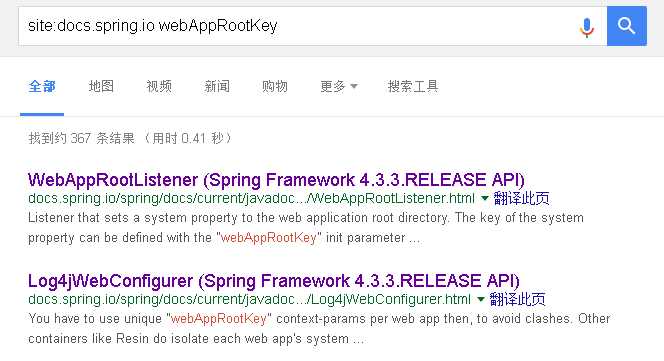标签:
Spring MVC 中的web.xml 中这个配置是什么意思呢?
<context-param> <param-name>webAppRootKey</param-name> <param-value>myfirstapp.root</param-value> </context-param>
查找资料后这个是由Spring 定义的一个值

具体作用在源码中:
/* * Copyright 2002-2008 the original author or authors. * * Licensed under the Apache License, Version 2.0 (the "License"); * you may not use this file except in compliance with the License. * You may obtain a copy of the License at * * http://www.apache.org/licenses/LICENSE-2.0 * * Unless required by applicable law or agreed to in writing, software * distributed under the License is distributed on an "AS IS" BASIS, * WITHOUT WARRANTIES OR CONDITIONS OF ANY KIND, either express or implied. * See the License for the specific language governing permissions and * limitations under the License. */ package org.springframework.web.util; import javax.servlet.ServletContextEvent; import javax.servlet.ServletContextListener; /** * Listener that sets a system property to the web application root directory. * The key of the system property can be defined with the "webAppRootKey" init * parameter at the servlet context level (i.e. context-param in web.xml), * the default key is "webapp.root". * * <p>Can be used for toolkits that support substition with system properties * (i.e. System.getProperty values), like log4j‘s "${key}" syntax within log * file locations. * * <p>Note: This listener should be placed before ContextLoaderListener in <code>web.xml</code>, * at least when used for log4j. Log4jConfigListener sets the system property * implicitly, so there‘s no need for this listener in addition to it. * * <p><b>WARNING</b>: Some containers, e.g. Tomcat, do NOT keep system properties separate * per web app. You have to use unique "webAppRootKey" context-params per web app * then, to avoid clashes. Other containers like Resin do isolate each web app‘s * system properties: Here you can use the default key (i.e. no "webAppRootKey" * context-param at all) without worrying. * * <p><b>WARNING</b>: The WAR file containing the web application needs to be expanded * to allow for setting the web app root system property. This is by default not * the case when a WAR file gets deployed to WebLogic, for example. Do not use * this listener in such an environment! * * @author Juergen Hoeller * @since 18.04.2003 * @see WebUtils#setWebAppRootSystemProperty * @see Log4jConfigListener * @see java.lang.System#getProperty */ public class WebAppRootListener implements ServletContextListener { public void contextInitialized(ServletContextEvent event) { WebUtils.setWebAppRootSystemProperty(event.getServletContext()); } public void contextDestroyed(ServletContextEvent event) { WebUtils.removeWebAppRootSystemProperty(event.getServletContext()); } }
/** * Set a system property to the web application root directory. * The key of the system property can be defined with the "webAppRootKey" * context-param in <code>web.xml</code>. Default is "webapp.root". * <p>Can be used for tools that support substition with <code>System.getProperty</code> * values, like log4j‘s "${key}" syntax within log file locations. * @param servletContext the servlet context of the web application * @throws IllegalStateException if the system property is already set, * or if the WAR file is not expanded * @see #WEB_APP_ROOT_KEY_PARAM * @see #DEFAULT_WEB_APP_ROOT_KEY * @see WebAppRootListener * @see Log4jWebConfigurer */ public static void setWebAppRootSystemProperty(ServletContext servletContext) throws IllegalStateException { Assert.notNull(servletContext, "ServletContext must not be null"); String root = servletContext.getRealPath("/"); if (root == null) { throw new IllegalStateException( "Cannot set web app root system property when WAR file is not expanded"); } String param = servletContext.getInitParameter(WEB_APP_ROOT_KEY_PARAM); String key = (param != null ? param : DEFAULT_WEB_APP_ROOT_KEY); String oldValue = System.getProperty(key); if (oldValue != null && !StringUtils.pathEquals(oldValue, root)) { throw new IllegalStateException( "Web app root system property already set to different value: ‘" + key + "‘ = [" + oldValue + "] instead of [" + root + "] - " + "Choose unique values for the ‘webAppRootKey‘ context-param in your web.xml files!"); } System.setProperty(key, root); servletContext.log("Set web app root system property: ‘" + key + "‘ = [" + root + "]"); }
它的作用就是
System.setProperty(key,root);
key 的默认值 "webapp.root"
给这个key 换一个名字
root 是 servletContext.getRealPath("/")
然后其他地方就可以使用啦! 包括log4j的配置文件中为文件指定位置,或者其他类中使用这个系统变量。
webapp.root=根目录
通过这个就可以变成
myfirstapp.root=根目录
每个项目都用各自的,避免混淆
标签:
原文地址:http://www.cnblogs.com/zno2/p/5901550.html